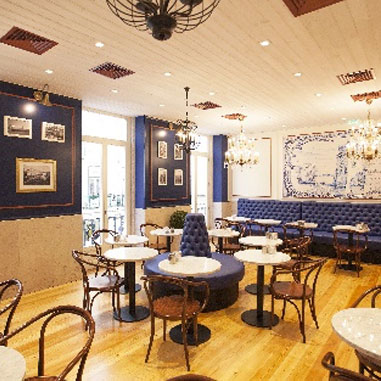Rossio Square
Start your day in the heart of downtown Lisbon: Rossio Square!Also known as Praça Dom Pedro IV, Rossio Square is a sunny and welcoming space that has witnessed countless celebrations, protests and events over the centuries.
In this square, surrounded by beautiful buildings such as the D. Maria II National Theatre, you’ll find two imposing water fountains and a statue of King Pedro IV holding the Constitutional Charter in his right hand.
Santa Justa Elevator
After crossing Rossio Square, it’s time to get lost in the Portuguese cobbled streets to the Santa Justa Elevator.
Designed by engineer Raoul Mesnier du Ponsard, the Santa Justa Elevator is a 19th century wrought iron masterpiece. It connects Rua do Ouro to Largo do Carmo, in Chiado, and as you go up you have access to a viewpoint that offers a splendid view over the city.
We recommend using the elevator to access the viewpoint and take a stroll through Largo do Carmo, Convento do Carmo and Chiado, but if the queue is long, you can also make your way to Largo do Carmo walking, it only takes a few minutes.
Largo do Carmo
Largo do Carmo is a calm and peaceful place with beautiful jacarandá trees, an 18th century fountain in the middle, surrounded by Pombaline buildings and the ruins of the Carmo Convent.
Carmo Convent
Located on top of a hill, the Carmo Convent is an impressive Gothic ruin dating back to the 14th century. It was founded by D. Nuno Álvares Pereira in 1389, but in 1755, the Lisbon Earthquake and subsequent fire left the Carmo Convent in ruins. Although downtown Lisbon was rebuilt, the same didn’t happen with the Carmo Convent, which became one of the main visible testimonies of this catastrophe.
Today, the Carmo Archaeological Museum has been installed on the site.
Chiado
Chiado is a neighbourhood with a vibrant mix of culture, commerce and gastronomy. . In its streets you’ll find statues of renowned Portuguese poets such as Fernando Pessoa and Luís de Camões, fashion stores, historic bookstores and charming cafés, creating a lively, cosmopolitan atmosphere.
After getting lost in the streets of Chiado, it’s time to head down to the trendy Rua Augusta.
Rua Augusta
Rua Augusta is one of the main pedestrian thoroughfares in Baixa – Downtown, full of stores, restaurants and street artists.
After this walk through Lisbon streets, take advantage of the fact that you’re on Rua Augusta to take a break and enjoy a typically portuguese experience!
Make a stop at the Fábrica da Nata to observe the process of making Pastéis de Nata and enjoy a Pastel de Nata with a glass of Port Wine. We recommend going up to the second floor of the store, where you’ll find an elegant and comfortable tea room with balconies overlooking Rua Augusta. On your way out, don’t forget to take your box of 6 warm Pastéis de Nata!
Rua Augusta Arch
At the end of the street stands the imposing Rua Augusta Arch, completed in 1875 as part of Lisbon’s post-earthquake reconstruction. For €3.50, you can climb up to the Miradouro do Arco da Rua Augusta, which offers a unique 360° Lisbon view.
Praça do Comércio
Once past the Rua Augusta Arch, you arrive at Praça do Comércio. For centuries, Praça do Comércio was the center of Lisbon’s political and commercial power, welcoming those arriving in Lisbon by boat.
Walk along Tejo river
Praça do Comércio is located on the riverside and offers a spectacular view over Tejo River. Take the opportunity to enjoy the view and take a quiet walk along the river.
Lisbon Cathedral – Sé
It’s time to get lost in the steep streets of Alfama, one of Lisbon’s most typical neighbourhoods! First stop: Lisbon Cathedral, or Sé, one of the oldest and most important churches in the city. Its construction began in the 12th century, and over the centuries it has undergone various modifications, displaying a mixture of architectural styles, including Romanesque, Gothic and Baroque.
Santa Luzia Viewpoint
Elétrico 28
The yellow train is a striking image of Lisbon! From downtown you can take Tram 28, which connects various points on this route, from Chiado to the Lisbon Cathedral (Sé) and the Santa Luzia viewpoint. We recommend a trip on Tram 28 for a very Portuguese experience, a panoramic tour of Lisbon and an easy climb up the hill to the viewpoints.Portas do Sol Viewpoint
Another viewpoint that offers a breathtaking view of Lisbon! There are also several terraces where you can enjoy a refreshing drink and contemplate the view.
Castelo de São Jorge – St. George’s Castle
One of Lisbon’s most emblematic landmarks, Castelo de São Jorge dominates the city’s landscape. Built by the Moors in the 11th century, it offers a fascinating journey through Portugal’s history as well as breathtaking panoramic views.
Graça Viewpoint
Finish your Lisbon tour at the Miradouro da Graça, a viewpoint that offers you a view of all the most striking features of Lisbon: Castelo de S. Jorge, the 25 de Abril Bridge, the Tejo River, the ruins of the Carmo Convent and the entire downtown area of Lisbon.
From the Miradouro da Graça, if you want to return to downtown, you can shorten your descent using the elevator – Funicular da Graça.









